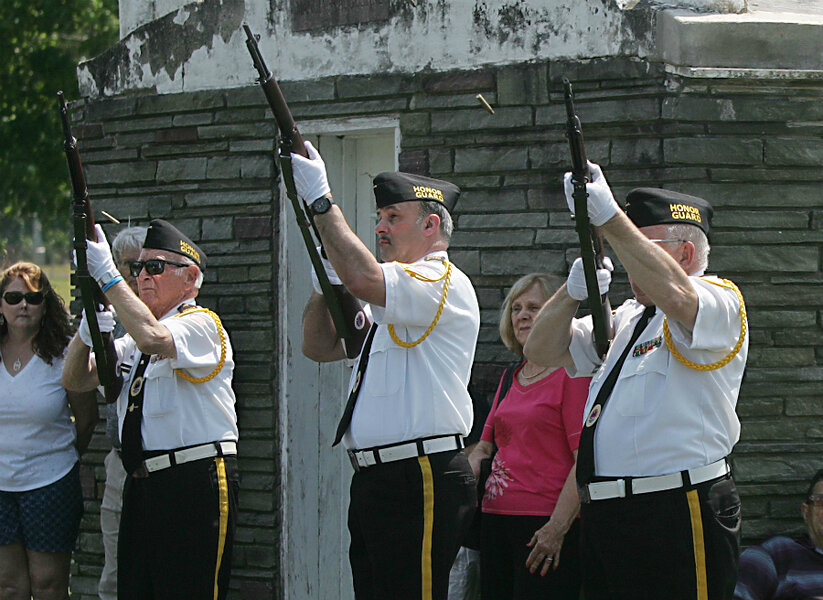It’s Memorial Day. Who are we remembering?
Loading...
| Washington
It’s Memorial Day. Who are we remembering?
You’d think that is an easy question to answer, but it isn’t. There’s an official definition of Memorial Day, and then there’s the way American citizens actually celebrate it. The two don’t always mesh.
Memorial Day, to the US government, is the time to remember those who died while serving in the military.
“In observance of the holiday, many people visit cemeteries and memorials, and volunteers often place American flags on each gravesite at national cemeteries. A national moment of remembrance takes place at 3:00 p.m. local time,” reads the Department of Veterans Affairs explanation.
It began as a sectional celebration, with its roots in division, and was known as Decoration Day. Following the end of the Civil War, North and South separately developed the tradition of decorating the graves of fallen soldiers, on separate days.
Some Southern locations held their decoration day (lower-cased in the beginning) on May 10, the anniversary of Stonewall Jackson’s death. Others held it on April 26, the day the surrender of the final Confederate Army in the field truly ended the war, or on June 3, Jefferson Davis’s birthday.
Northerners also generally remembered their war dead on spring days. That was when flowers were available for wreaths and memorial sprays, after all. In 1868, US Army Gen. John Logan, commander in chief of the Grand Army of the Republic, the politically powerful organization of Union veterans, issued a general order naming May 30 as a day to mound the graves of the war dead with “the choicest flowers of spring time.”
The melding of regional remembrance into a national one was a gradual process. Following the brief Spanish-American War of 1898, President William McKinley got things started, with a speech in Atlanta in which he said, “Every soldier’s grave made during our unfortunate Civil War is a tribute to American valor.” In the summer of 1913, an encampment of Civil War veterans at Gettysburg, Pa., which included many former Confederates, helped move the two sides further to reconciliation.
But it took further shared suffering to make Decoration Day national. In the wake of the national effort in World War I the regional aspect of the holiday began to fade. Following the armistice most southern regions began to celebrate the May 30 holiday in addition to their local decoration days.
World War II further diminished the Civil War origins of Decoration Day in the collective national memory. In 1967, federal law officially recognized the holiday as “Memorial Day,” the by-then common name. In 1968, Congress passed the Uniform Monday Holiday Act, which established a number of three-day US holidays. Memorial Day was officially set as the last Monday in May.
Over the years the holiday’s purpose began to change. Its date has made it an unofficial start of summer. For some Americans, its name had made it a time to remember veterans as a whole, not just those who died in uniform.
Veterans’ Day, in November, is the holiday meant to recognize all who served in the armed forces. But how many social media posts today have you seen that mention the military as an institution? We’re betting lots. On its mobile interface, Facebook this morning posted what appears to be an institutional post (company logo in the corner) to that effect, saying that “Today, we remember together . . . those who have served our country.”
It’s not uncommon for holidays to transform a bit – George Washington’s Birthday, the official name of the February holiday, has morphed in the public mind into “President’s Day,” an all-encompassing celebration of all things national chief executive. As we’ve written often over the years, President’s Day, in a national sense, does not exist. Yet there it is, in car and mattress ads in every remaining American newspaper.
Americans develop their own traditions. Our wife’s New England family upholds the Decoration Day aspects of today, but in their own way – it’s traditional for family members to travel around and decorate with flowers the gravesites of all ancestors, whether they served in the military or not.
There’s nothing wrong with that. Memorial Day is what individuals make of it. That’s the kind of freedom our veterans – including those who sacrificed their lives – protected, and our armed forces, including those once again near the front lines fighting the Islamic State, are protecting today.








